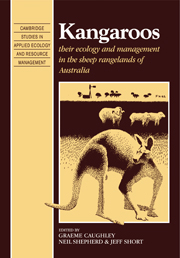Book contents
- Frontmatter
- Contents
- Preface
- Dedication
- THE STUDY AREA IN CONTEXT
- 1 Introduction to the sheep rangelands
- 2 The environment of the Australian sheep rangelands
- 3 The effect of weather on soil moisture and plant growth in the arid zone
- 4 Plant dynamics
- 5 The diet of herbivores in the sheep rangelands
- 6 Factors affecting food intake of rangelands herbivores
- 7 The mobility and habitat utilisation of kangaroos
- 8 Kangaroo dynamics
- 9 Condition and recruitment of kangaroos
- 10 Ecological relationships
- 11 Options for management of kangaroos
- Appendices to Chapter 8
- REFERENCES
- Author index
- Subject index
3 - The effect of weather on soil moisture and plant growth in the arid zone
Published online by Cambridge University Press: 05 November 2011
- Frontmatter
- Contents
- Preface
- Dedication
- THE STUDY AREA IN CONTEXT
- 1 Introduction to the sheep rangelands
- 2 The environment of the Australian sheep rangelands
- 3 The effect of weather on soil moisture and plant growth in the arid zone
- 4 Plant dynamics
- 5 The diet of herbivores in the sheep rangelands
- 6 Factors affecting food intake of rangelands herbivores
- 7 The mobility and habitat utilisation of kangaroos
- 8 Kangaroo dynamics
- 9 Condition and recruitment of kangaroos
- 10 Ecological relationships
- 11 Options for management of kangaroos
- Appendices to Chapter 8
- REFERENCES
- Author index
- Subject index
Summary
Introduction
Rainfall is the dominant factor controlling the growth of plants in arid lands throughout the world (Beatley, 1969; Ross, 1969, 1976; Noy-Meir, 1973; Ross & Lendon, 1973; Gutterman, 1981; Orr, 1981). Much of the variability of pasture biomass can be explained by rainfall (Noy-Meir, 1973; Chapter 4). Temperature also plays a role in the initiation and success of germination and the survival of seedlings (Beatley, 1967; Gates & Muirhead, 1967; Lendon & Ross, 1978). Hence, rain falling at different seasons in the arid zone stimulates the germination of different suites of plant species.
This chapter reports the effect of rainfall and temperature on changes in soil moisture, pasture biomass, pasture growth and species composition on the two major soil types of Kinchega National Park.
The study posed the following questions:
(1) What is the relationship between rainfall and soil moisture and how does it differ between the two major soil types within the Park?
(2) Can trends in soil moisture or a knowledge of rainfall and temperature be used to predict changes in pasture growth and biomass?
The study was conducted within two exclosures, one on each of the two major soil types within Kinchega National Park. A fence excluded mammalian herbivores. Hence, growth, dieback and trends in biomass are measured in the absence of grazing. There is considerable evidence that grazing affects the growth rate of plants, sometimes stimulating growth and sometimes depressing growth or killing the plant (Harper, 1977; McNaughton, 1979).
- Type
- Chapter
- Information
- KangaroosTheir Ecology and Management in the Sheep Rangelands of Australia, pp. 35 - 49Publisher: Cambridge University PressPrint publication year: 1987
- 5
- Cited by

